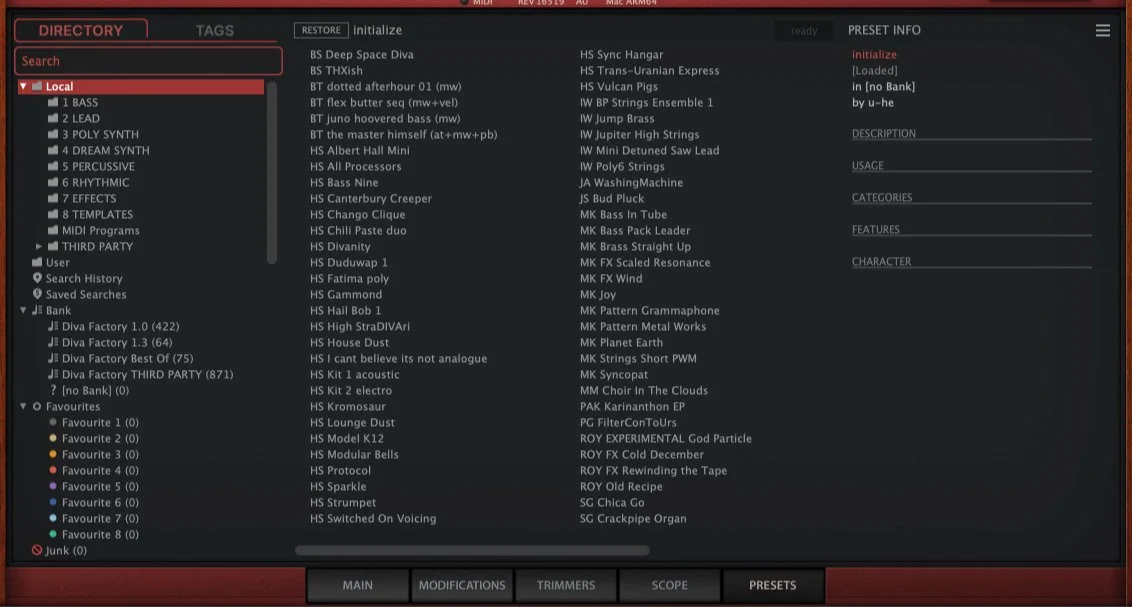u-he Diva Review: Is This Still an Essential Synth VST in 2025?

u-he Diva isn’t a new synth. In fact, it’s been around for over a decade—which makes it kind of incredible that it’s still one of the most talked-about synth plugins today. While newer plugins keep pushing into modular routing, wavetable complexity, or AI-driven sound generation, Diva stays rooted in a different philosophy: authentic analog modeling, done to the highest standard possible. It doesn’t try to do everything—it just tries to sound amazing. And it does. For many producers, Diva is still the go-to plugin when they want classic warmth, richness, and that “real” analog feeling from a soft synth. I’ve interviewed around a hundred artists for this blog, asking them what their go-to VST synth is—and along with Serum, Diva is the name that comes up more than any other. That’s not because it’s trendy. It’s because it has a reputation for delivering serious results. Whether you’re making techno, cinematic scores, bedroom pop, or deep house, Diva has the kind of tone and depth that feels finished right out of the box. Is Diva the synth for you? Let’s find out.
u-he Diva Review: Is This Still an Essential Synth VST in 2025?
Disclosure: This post contains affiliate links. If you buy something through these links, I may earn a commission at no extra cost to you. As an Amazon Associate, I earn from qualifying purchases.
1. Diva Lets You Create your Dream Vintage Synth
Diva’s reputation is built on one thing above all else: its sound. Even in a crowded plugin market, it still stands out for its ability to deliver that unmistakable analog-style weight and richness. This isn’t just marketing talk—Diva’s underlying tech models individual components of classic hardware synths, and the result is a tone that feels alive, with depth, saturation, and subtle movement you usually only get from real analog gear. Whether you're dialing in warm pads, squelchy acid leads, or thumpy basslines, it feels like you're working with a physical instrument, not just a software patch.
What’s especially cool is how you can mix and match modules from different synth eras. You’re not locked into one emulation—you can take an oscillator modeled on a Minimoog, run it through a Roland-style filter, then shape it with MS-20 envelopes. That kind of flexibility means you can recreate vintage classics or explore entirely new territory. And for all its sonic weight, Diva doesn’t rely on FX tricks—it sounds great dry, which is a rare and telling quality in a soft synth.
For hobbyist producers, that means two things: you can get pro-quality analog sound without buying vintage gear, and you don’t need a ton of plugins to fake it. Diva’s character comes through clearly in a mix, even without layering or processing. If sound quality is your top priority and you’re hunting for a plugin that just sounds expensive, Diva really does deliver.
2. Diva’s Presets Are Actually Worth Using
One of Diva’s biggest strengths is how quickly it delivers inspiring sounds—even if you’re not into sound design. The factory presets are genuinely useful, covering everything from classic analog basses to lush pads, punchy leads, and warm keys. They’re well-organized, clearly named, and give you an instant sense of what Diva is capable of. Whether you’re sketching out an idea or looking for a finished sound that just fits, there’s a lot to work with right out of the box.
The real magic of Diva reveals itself when you start experimenting. Whether you're tweaking a preset or building a sound from scratch, even small changes—like adjusting a filter, swapping an envelope shape, or switching oscillator types—can dramatically transform the result. The interface is designed to encourage this kind of exploration: it looks and feels like hardware, with no hidden menus or convoluted routing to slow you down. You can mix and match modules, dial in analog drift, and instantly hear the impact of every move. It’s a hands-on experience that’s both intuitive and rewarding, especially if you're starting to explore sound design.
There’s also a thriving scene of third-party preset packs made for Diva, many of which are genre-specific and sound fantastic. If you want synthwave basses, cinematic textures, deep house chords—there’s probably a pack for it. So even if you stick to presets at first, there’s room to grow into the synth’s deeper potential. You don’t need to be an expert to use Diva well, but if you enjoy experimenting, it’ll reward you with some of the richest sounds you can get from a soft synth.
3. The Interface Feels Like Real Hardware
One of the reasons Diva stands out among soft synths is how tactile and intuitive it feels to use. The interface is modeled after real analog gear—not just in looks, but in how you interact with it. Every section is clearly laid out: oscillators on the left, filter and envelopes in the middle, modulation and effects on the right. There’s no endless menu diving or hidden tabs to slow you down. It’s the kind of plugin you can learn by feel, just like you would with a hardware synth.
What makes it especially fun is the way you can swap out modules to build your own ideal signal path. Want a Moog-style filter with Juno-style oscillators? You can do that. Prefer a punchy digital envelope with a warm analog vibe? Just click and switch. Diva gives you control over the building blocks of your synth voice in a way that feels playful instead of overwhelming. It’s deep, but not intimidating.
There are also thoughtful touches that make the experience smoother. Everything reacts in real time with visual feedback, so you can see as well as hear the effect of what you’re doing. The layout encourages you to explore, even if you're not entirely sure what each module does at first. For producers who want to move beyond presets and into hands-on control, Diva offers one of the most satisfying interfaces out there—it feels less like software, and more like an instrument.
4. Diva’s One Downside (and the Best Alternatives)
Diva’s most well-known downside is also a clue to why it sounds so good: it’s a CPU-hungry synth. Unlike a lot of virtual analog plugins that cut corners to save resources, Diva puts accuracy first. Its “divine analog” modeling includes zero-delay feedback filters, component-level emulation, and high-quality oscillator behavior—all of which sound amazing but ask a lot from your computer. If you’re working on a laptop or loading up multiple instances in a busy project, you’ll probably notice the strain.
There are ways to work around this. Diva includes draft, fast, and accurate modes so you can compose in lower quality and then switch to high-quality rendering later. You can also freeze or bounce tracks to save resources once you’ve locked in your sound. But it’s definitely a synth you want to plan around. If you're mainly looking for something lightweight and versatile for quick sketches, Diva might feel like overkill.
That said, Diva’s demanding nature has opened the door for some compelling alternatives—especially for users who don’t need full-on analog emulation. If you want something free and CPU-light, Vital is a popular wavetable synth with surprisingly deep capabilities and a clean, modern interface. Arturia Pigments offers hybrid synthesis (analog, wavetable, sample, additive) with more modulation options and less system load, making it a flexible creative tool. And for a warmer sound in a smaller footprint, TAL-U-No-LX is a fantastic Juno emulation with a vintage vibe and way less strain on your CPU. But while these options are great in their own right, none of them quite nail the depth, weight, and realism that Diva brings—if that’s what you’re after, it’s still in a league of its own.
Should You Buy Diva in 2025?
If you’ve been eyeing Diva and wondering whether it’s still worth buying, the short answer is: yes—if sound quality is what matters most to you. Diva isn’t the newest synth on the market, but it remains one of the best-sounding. The warmth, depth, and analog realism it delivers is still hard to match in 2025, and its interface strikes a rare balance between ease of use and deep control. It’s especially rewarding if you’re willing to explore and build your own patches—but even if you’re not, the factory content and preset ecosystem give you a lot to work with right away.
That said, it’s not for everyone. If you're working on an older machine or need a synth that can run dozens of instances without straining your CPU, you might want to look elsewhere. And if you're more interested in wild modulation or modern synthesis techniques like wavetable blending or granular textures, you might find something like Pigments, Phase Plant, or even u-he’s own Hive 2 better suited to your needs. But if what you want is a go-to analog-style synth plugin that sounds expensive, feels like an instrument, and will likely still be relevant years from now—Diva is still the one.
Stay in the loop! Subscribe to our newsletter for the best deals and limited-time freebies
👇👇👇
Disclosure: This post contains affiliate links. If you buy something through these links, I may earn a commission at no extra cost to you. As an Amazon Associate, I earn from qualifying purchases.



